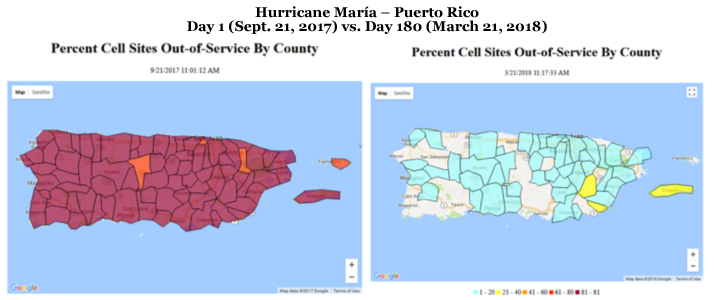FCC report: Hurricane María knocked out 95.2% of cell sites in P.R.

Hurricane María knocked out 95.2 percent of cell sites in Puerto Rico after it clobbered the island nearly a year ago, the Federal Communications Commission confirmed in a report released analyzing the effects of last year’s deadly storm.
Furthermore, all of the island’s 78 had greater than 75 percent of their cell sites out of service, while 48 out of the 78 municipalities in Puerto Rico had 100 percent of their cell sites out of service.
“Hurricane Maria struck the Caribbean islands just two weeks after Hurricane Irma; it further damaged the still-recovering communications infrastructure in the U.S. Virgin Islands, and severely degraded that of Puerto Rico; essentially, the communications infrastructures of both Puerto Rico and the USVI were almost completely destroyed,” the FCC stated in its “2017 Atlantic Hurricane Season Impact on Communications” report.
In its analysis, the FCC highlighted the role played by amateur radio operators, which it described as “essential.” Post-María, the American Radio Relay League partnered with the Red Cross and Salvation Army in an initiative known as the “Force of 50,” in which volunteer amateur radio operators assisted in relief efforts by providing information on survivors for their families on the continental United States.
In its analysis, the FCC also included the impacts caused by Hurricanes Irma and Harvey both in the Caribbean and stateside, respectively. Hurricane María dealt $100 billion in damages to Puerto Rico, including the communications infrastructure.
While the emergency call centers on the mainland stood up to last year’s storms, “the 911 call centers serving Puerto Rico and the USVI were impacted, and were either completely out of service for a period of time [as happened in the USVI,] or could not receive the types of information [location, call back number, etc., as happened in both Puerto Rico and the USVI,]” the FCC report noted.
“Between them, Puerto Rico and the USVI have only four 911 call centers — two each — to serve 3.4 million people; for some time, none of those call centers were fully functional,” the FCC noted.
The regulatory agency also confirmed that communications beyond wireless service also came to a virtual stand-still for weeks in Puerto Rico after Hurricane María.
“Downed broadcasting antennas, lack of power, a dearth of resources, destroyed telephone poles, and similar factors, combined to devastate communications on Puerto Rico and the USVI for months,” the agency noted.
“As a snapshot-in-time, on Dec. 6, 2017, several weeks after Hurricane María made landfall, five television stations in Puerto Rico were reported as operational, while 100 were not functioning,” the FCC confirmed.
“Roughly one-third of AM and FM radio stations remained out-of-service. Cable system and wireline phone service remained generally non-existent, owing mostly to the lack of power,” the FCC added.
Going forward, the FCC plans to take a number of steps to prepare ahead of possible storms. It will work with telecom providers and local and federal governments to take preventive actions.
The agency also urged consumers to familiarize themselves with information and guidance that the FCC and their service providers provide on communications during an emergency, “and what steps they can take to increase the likelihood that their communications devices will be useful during a crisis.”










